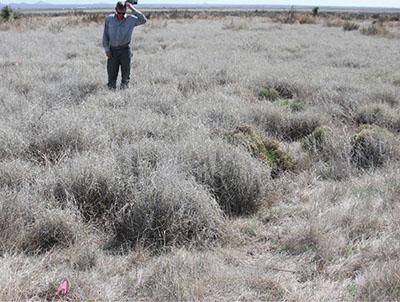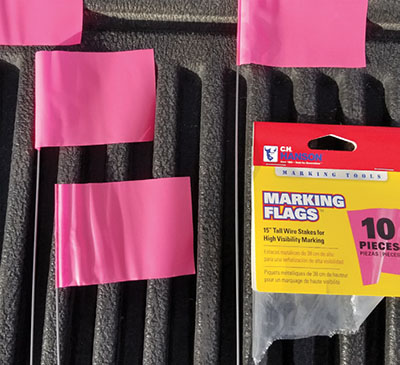Is There Enough Grass? Balancing Forage Supply and Demand
LPC-3
Christopher D. Allison
College of Agricultural, Consumer and Environmental Sciences, New Mexico State University
Author: Rangeland Scientist, Linebery Policy Center for Natural Resource Management, New Mexico State University. (Print Friendly PDF)
Introduction
Balancing forage supply and demand on rangelands is the first priority for properly managing these grazing lands. A correct stocking rate that achieves a desired level of use to meet livestock needs while ensuring future range productivity is the overarching goal all ranchers strive to meet. This manuscript offers range livestock producers a simple, fast approach to check forage supply relative to current livestock grazing pressure.
Most ranchers rely on past experience when establishing and adjusting stocking levels. Miscalculations or poor memories often result in an overstocked ranch, resulting in a “sell all” situation or purchasing feed to maintain the base herd until better precipitation and forage growth occur. Economically, neither option is recommended. Cattle prices are depressed during drought and feed is expensive.
Land management agencies and range management consultants rely on forage inventories and analyses in the belief that we can accurately capture the forage supply and demand picture on a ranch management plan. A wide variety of vegetation sampling and livestock intake assumptions are used in arriving at the correct stocking level. Assumptions used include forage production (lb/acre), forage intake by range livestock, efficiency of harvest by grazing animals, even distribution of grazing pressure, and a “normal” growing season to produce an “average” forage production year. Obviously, a large number of combinations of these variables are possible over time. A simpler, proactive method is needed for land managers and ranchers to address the changes in rangeland production across seasons and years.
Not only does rangeland productivity change throughout the year but, concomitantly, livestock forage intake changes with the animal’s age, growth rate, physiological status, body weight, and environmental conditions (Allison and Kothmann, 1979). Forage quality, normally expressed as crude protein and digestibility, is a major factor that determines the rate of passage and intake. Forage quality changes daily and cannot be quickly measured when determining forage intake.
Forage harvest efficiency is illustrative of further complexities in the forage supply and demand equation. Simply stated, all the forage that disappears over a day, month, year, season, or grazing cycle does not equal animal consumption. There have been a few studies that attempted to quantify this harvest efficiency (Allison et al., 1982; Smart et al., 2010). Roughly one half of forage disappearance is unaccounted for with grazing animal intake levels.

(Photo courtesy of John Wenzel.)
Grazing Capacity
A typical approach to determining rangeland grazing capacity often involves a variation of the below calculations:
- (pasture acreage × lb/acre) × 0.50 utilization desired = lb forage available
- lb forage available × 0.50 harvest efficiency = lb forage available for livestock
- lb forage available for livestock / 780 lb = animal unit months (AUMs) available
NOTE: 780 lb of forage is the estimated intake for one animal unit for one month.
Animal unit equivalents used in stocking calculations are 1.0 AU for a cow with or without a calf at its side, 1.5 AU for bulls, and 0.6 AU for weaned calves and yearlings.
These calculations depend on having an accurate estimate of forage production. This is a daunting task for any rangeland specialist because it requires a large sample size to give a value that is within a 90% confidence level. Most ranchers have neither the desire, time, nor training to arrive at a reliable carrying capacity figure using these types of calculations.
White and Troxel (1992) and Allison (1993) go into great detail on methodologies for balancing forage supply and demand. Anyone needing detailed information and methodologies should refer to these publications.
Animal Days Per Acre
Oftentimes, ranchers need to evaluate their rangelands to project if there is enough forage to carry their cattle, horses, sheep, goats, or other livestock through the year. This is especially critical during the early stages of drought. Most people do not have the time to conduct an in-depth range vegetation survey.
An alternative to an in-depth survey is to use the animal days per acre (ADA) concept to measure vegetation. This method has been used by range management consultants, ranchers, educators, and conservationists for several years to make quick stocking decisions. To illustrate the utility of the ADA concept, consider the following hypothetical situation:
1) It is end of August and rainfall has been below average. 2) If no more precipitation falls, the next expected growth period will begin next July. 3) This equates to 10 months of no forage growth. 4) The rancher needs to determine if there is enough forage to support their livestock for the next 10 months.
The field check method is illustrated below:
- Question: Is there enough grass to last until the next growing season?
- Example scenario: 100 cows, 5,000 acres, 10 months of potentially no growth (September–June)
- (100 cows × 300 days) / 5,000 acres = 6 animal days per acre
- Each acre must be able to support 6 animals for 1 day.
- Reducing this value down to the area needed for one animal for one day:
- 43,560 ft2 / 6 = 7,260 ft2 allocated for one animal for one day
- √7,260 = 85 ft
- An 85 ft × 85 ft area needs to be checked in the field (Figure 1).
- Will this area be sufficient to provide enough forage for one animal for one day? Remember, a mature cow will consume 20–25 lb dry matter per day.
- If the determination is “yes,” forage supply is adequate.
- If one hesitates, the answer is probably “no,” and a reduction in stocking is needed.

Figure 1. After delineating the area allocated to one cow for one day, visually appraise the area to determine if there is enough forage to support the animal while also leaving sufficient residual vegetation for site protection and plant health.
After performing this field check exercise across the ranch, the rancher is then able to make a proactive decision to reduce stocking or not. The sooner one determines that a reduction is needed, the less total number of cattle will need to be removed.
Waiting until late in the dormant season to make stocking decisions often results in needing to reduce all livestock. The sooner a decision is made to reduce cattle numbers to match forage supply, the less total number of cattle will need to be sold.
When performing these field checks, the rancher must be cognizant of a few precautions. First, avoid really high production areas. Second, perform the field check in several different areas across the range. Finally, be sure to mentally factor in the desired stubble height at the end of the forage budgeting time frame. We never want to graze plants to the ground level.
The ADA field check may appear to be overly simple, but years of experience have demonstrated its utility in providing ranchers a method to get control of forage budgeting before they run out of grass.
Supplies needed include surveying flags (Figure 2), a calculator with a square root function, and knowledge of your pace length. Don’t worry about being precise in field measurements because this procedure is designed to be a rapid estimate of the forage supply allocated to the livestock. Numerous sampling locations are more valuable than the precision of each sample.

Figure 2. Marking flags of appropriate length are an easy way to mark the four corners of the calculated area needed for one animal for one day.
Literature Cited
Allison, C.D. 1993. Balancing forage supply and demand [Guide B-115]. Las Cruces: New Mexico State University Cooperative Extension Service.
Allison, C.D., and M.M. Kothmann. 1979. Effect of level of stocking pressure on forage intake and diet quality of range cattle. Proceedings, Western Section, American Society of Animal Science, 30, 174–178.
Allison, C.D., M.M. Kothmann, and L.R. Rittenhouse. 1982. Efficiency of forage harvest by grazing cattle. Journal of Range Management, 35, 351–354.
Smart, A.J., J.D. Derner, J.R. Hendrickson, R.L. Gillen, B.H. Dunn, E.M. Mousel, P.S. Johnson, R.N. Gates, K.K. Sedivec, K.R. Harmoney, J.D. Volesky, and K.C. Olson. 2010. Effects of grazing pressure on efficiency of grazing on North American Great Plains rangelands. Rangeland Ecology and Management, 63, 397–406.
White, L.D., and T.R. Troxel. 1992. Balancing forage demand with forage supply [B-1606]. College Station: Texas A&M University AgriLife Extension.
For Further Reading
LPC-1: Economic Contribution of the Beef Cattle Industry to New Mexico
https://pubs.nmsu.edu/specialty/lpc/LPC1/
LPC-2: A Common-sense Criterion in the Evaluation Of Wilderness
https://pubs.nmsu.edu/specialty/lpc/LPC2/
RITF-87: Proceedings: Range Improvement Task Force 2016 Livestock Water Symposium (Saturday, September 10, 2016 MCM Elegante Hotel, Albuquerque, New Mexico)
https://pubs.nmsu.edu_ritf/RITF87/

The Linebery Policy Center for Natural Resources Management provides policy analysis and promotes the visibility of and advocates for the beneficial use of natural resources through education.

Christopher D. Allison is a rangeland scientist for the Linebery Policy Center for Natural Resource Management. He earned his Ph.D. in range science from Texas A&M University. His professional interests and expertise include range animal nutrition, grazing management, and range plant toxicology.
To find more resources for your business, home, or family, visit the College of Agricultural, Consumer and Environmental Sciences on the World Wide Web at pubs.nms.edu.
Contents of publications may be freely reproduced, with an appropriate citation, for educational purposes. All other rights reserved. For permission to use publications for other purposes, contact pubs@nmsu.edu or the authors listed on the publication.
New Mexico State University is an equal opportunity/affirmative action employer and educator. NMSU and the U.S. Department of Agriculture cooperating.
October 2019 Las Cruces, NM


